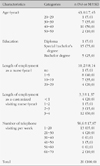Abstract
Purpose
The purpose of this study was to explore and understand customized home visiting nurses' experiences in telephone visiting.
Methods
Qualitative data were collected from several discussions of 4 focus groups consisting of 20 customized home visiting nurses. All interviews were recorded and transcribed according to thematic content analysis processes.
Results
The five main themes on customized home visiting nurses' experiences of telephone visiting were 'greeting', 'counseling', 'using strategies', 'maintaining attitude for enhancing relations' and 'enduring difficulties'. The category of 'counseling' was composed of confirming, educating, supporting, adjusting, and indicating. And, the category of 'using strategies' included complimenting, scolding, persuading, compensating, and ignoring.
Figures and Tables
References
1. Bandura A. The anatomy of stage of change. Am J Health Promot. 1997; 12(1):8–10.
2. Gyeongsang National University. Management of program development with customized home visiting health service 2010-2012. Jinju: Author;2010.
3. Han HR, Kim JY, Kim KB, Jeong SH, Levine D, Li CY, et al. Implementation and success of nurse telephone counseling in linguistically isolated Korean American patients with high blood pressure. Patient Educ Couns. 2010; 80(1):130–134.

4. Hsieh HF, Shannon SE. Three approaches to qualitative content analysis. Qual Health Res. 2005; 15(9):1277–1288.

5. Jang HS, Hyoung HK, Kim KH. Comparison of health related characteristics and self-care behavior between a hypertension controlled group and a non controlled group of hypertension patients in a customized home visiting health service. J Korean Acad Community Health Nurs. 2009; 20(4):483–492.
6. Kahneman D, Tversky A. Prospect theory: An analysis of decision under risk. Econometrica. 1979; 47(2):263–292.

7. Kim CG, Chung CH. Effects of telephone consulting program on self-efficacy and self-care in NIDDM patients. J Korean Acad Adult Nurs. 2002; 14(2):306–314.
8. Kim JE, Park HA. Demonstration project on utilization of telephone consulting and telemedicine system for home health care of the elderly. J Nurs Acad Soc. 1996; 26(3):576–590.

9. Kim SY, Cho BH, Nam HS. Effect of case management program on self-efficacy, self-care behaviors and glycometabolic control in patient with diabetes. J Agric Med Community Health. 2008; 33(2):232–242.

10. Kolt GS, Schofield GM, Kerse N, Garrett N, Oliver M. Effect of telephone counseling on physical activity for low-active older people in primary care: A randomized, controlled trial. J Am Geriatr Soc. 2007; 55(7):986–992.

11. Korea Institute for Health and Social Affairs. Reevaluation of case management of customized home visiting health service (2009-04-01, 02, 03, 04, 05, 06). Seoul: Korea Institute for Health and Social Affairs Management Center for Health Promotion;2009.
12. Lee BC. The effect of message frame in self care education of patients with DM. Jinju: Gyeongsang National University;2006. Unpublished master's thesis.
13. Lee HJ, Kim KR, Kim JS, Shin JS. Effects of the problem-solving telephone counseling on caregiving appraisal and coping in family caregivers of the older adults with dementia. J Korea Gerontol Soc. 2004; 24(1):21–36.
14. Lee JR. The effects of telephone counseling on patient management: A literature review. Korean Clin Diabetes. 2010; 11:297–302.

15. Long AF, Gambling T, Young RJ, Taylor J, Mason JM. Acceptability and satisfaction with a telecarer approach to the management of type 2 diabetes. Diabetes Care. 2005; 28(2):283–289.

16. Lorig K, Ritter PL, Villa F, Piette JD. Spanish diabetes self-management with and without automated telephone reinforcement: Two randomized trials. Diabetes Care. 2008; 31(3):408–414.
17. Miller WR, Rollnick S. Motivational interviewing: Preparing people for change. New York: Guilford;2002.
18. Ministry of Health & Welfare. The guidance of tailored home visiting health service. Seoul: Author;2009a.
19. Ministry of Health & Welfare. The result of 2008 tailored home visiting health service. Seoul: Author;2009b.
20. Ministry of Health & Welfare. The standard mannual for focused health management. Seoul: Author;2010.
21. Morgan DL. Focus groups as qualitative research. 2nd ed. Thousand Oaks, CA: Sage;1997.
22. Newman VA, Flatt SW, Pierce JP. Telephone counseling promotes dietary change in healthy adults: Results of a pilot trial. J Am Diet Assoc. 2008; 108(8):1350–1354.

23. Park JS, Oh YJ. The effect of case management for clients with hypertension, DM registered in customized home visiting health care services. J Korean Acad Public Health Nurs. 2010; 24(1):135–150.
24. Park YS, Han KJ, Hah YS, Song MS, Kim SJ, Chung CW, et al. Effects of telephone counseling on health service satisfaction after discharge in gynecologic cancer women. J Korean Acad Soc Nurs Educ. 2008; 14(2):294–304.
25. Reese RJ, Conoly CW, Brossart DF. The attractiveness of telephone counseling: An empirical investigation of client perceptions. J Couns Dev. 2006; 84(1):54–60.

26. Sandelowski M. The problem of rigor in qualitative research. ANS Adv Nurs Sci. 1986; 8(3):27–37.

27. Song MS, Kim HS. Effects of the diabetes outpatient intensive management program on glycemic control for type2 diabetic patients. J Clin Nurs. 2007; 16(7):1367–1373.
28. Yang SO, Ahn SY, Yim ES, Kwon MS. The effects of customized home visiting-health service in Gangwon-do. J Korean Acad Community Health Nurs. 2008; 19(1):88–100.




 PDF
PDF ePub
ePub Citation
Citation Print
Print




 XML Download
XML Download